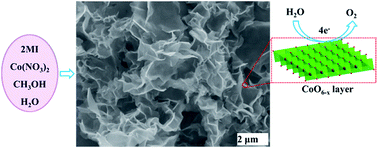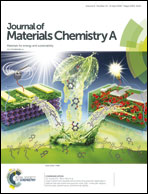Cobalt layered double hydroxide nanosheets synthesized in water–methanol solution as oxygen evolution electrocatalysts†
Abstract
Cobalt-based layered double hydroxides (Co-based LDHs) are cost-efficient electrocatalysts toward the oxygen evolution reaction (OER) associated with the conversion of clean and renewable energy. Herein we report a facile method for the in situ synthesis of monometallic Co LDH ultrathin nanosheets (UTNSs) through a one-step reaction between cobalt(II) nitrate and 2-methylimidazole (2MI) in water–methanol solution without the pre-synthesis of zeolitic imidazolate framework-67 (ZIF-67). The as-prepared Co LDH UTNSs possess atomic thickness, abundant oxygen vacancies and three-dimensional (3D) porous features. The best sample exhibits an outstanding OER performance on a glassy carbon electrode (GCE) with an overpotential (η) of 340 mV at 10 mA cm−2, a Tafel slope of 56 mV dec−1 and a turnover frequency (TOF) of 0.801 s−1 at η = 350 mV in 1 M KOH. A two-electrode cell with the Co LDH UTNSs as the anode catalyst and commercial Pt/C as the cathode catalyst achieves a current density of 10 mA cm−2 at the applied voltage of 1.625 V during the long-term electrolysis test. This work demonstrates a novel strategy based on water–methanol solution which is promising for the design and synthesis of ultrathin LDHs as highly active and stable catalysts applied in clean energy production.



 Please wait while we load your content...
Please wait while we load your content...